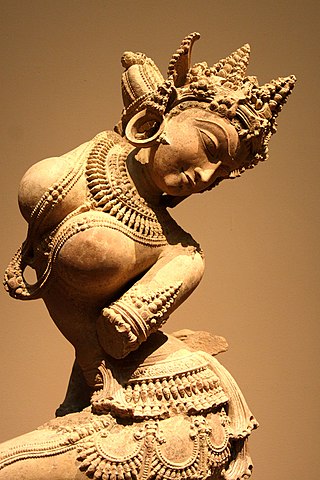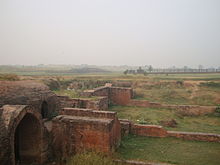
Kannauj is an ancient city, administrative headquarters and a municipal board or Nagar Palika Parishad in Kannauj district in the Indian state of Uttar Pradesh. The city's name is an evolved form of the classical name Kanyakubja. In Ancient Vedic period, it was famous city of Panchala Mahajanpada and also it's capital during Panchala king Vajrayudha.

Harshavardhana was a Pushyabhuti emperor who ruled northern India from 606 to 647 CE. He was the son of Prabhakaravardhana who had defeated the Alchon Hun invaders, and the younger brother of Rajyavardhana, a king of Thanesar, present-day Haryana.

Kurukshetra is a city and administrative headquarters of Kurukshetra district in the Indian state of Haryana. It is also known as Dharmakshetra and as the "Land of the Bhagavad Gita".

The Kurukshetra War, also called the Mahabharata War, is a war described in the Hindu epic poem Mahabharata, arising from a dynastic struggle between two groups of cousins, the Kauravas and the Pandavas, for the throne of Hastinapura. The war is used as the context for the dialogues of the Bhagavad Gita, which was interpolated into the Ramayana.

Kurukshetra district is one of the 22 districts of Haryana state in northern India. The town of Kurukshetra, a sacred place for the Hindus, is the administrative headquarters of this district. The district occupies an area of 1530.00 km2. The district has a population of 964,655. This district is part of Ambala division. Kurukshetra is also the land of Srimad Bhagawad Gita. Jyotisar is the place in Kurukshetra where Krishna is believed to deliver the sermon of Gita to Arjuna in the Mahabharata.

The ancient Sthaneshwar Mahadev Temple, dedicated to Shiva is situated in old Kurukshetra city Kurukshetra district of Haryana, India. It was here that the Pandavas along with Krishna are said to have prayed to Shiva and to have received his blessings for victory in the battle of Mahabharata. The ninth Guru, Shri Tegh Bahadur stayed at a spot near the Sthaneshwar Tirtha that is marked by a gurdwara just beside the temple.

Jyotisar, on the bank of Jyotisar Sarovar wetland, is a Hindu pilgrimage site in the city of Kurukshetra in Haryana state of India. According to Hindu tradition, Krishna delivered the sermon of Bhagavad Gita - the doctrine of Karma and Dharma to his wavering friend Arjuna to guide him to resolve his ethical dilemma and revealed his vishvarupa to him.
Abhimanyupur is a village in Kurukshetra district of Haryana, India. This village is 8 kilometres from the city of Kurukshetra. This village is famous for being the site where Abhimanyu, the son of Arjuna, died in the Mahabharata War. This is the site where the Kauravas arranged the deadly "chakravyuha" formation and trapped and killed Abhimanyu. This village is part of the 48 kos parikrama of Kurukshetra. This village has many sacred places associated with Hinduism.

Asigarh Fort, also called Hansi Fort, is located on the eastern bank of Amti lake in Hansi city of Haryana, India, about 135 km from Delhi on NH9. Spread over 30 acres, in its prime days this fort used to be in control of 80 forts in the area around it. The fort is said to be one of the most impregnable forts of ancient India and has been declared a centrally protected monument by ASI in 1937.

Sheikh Chilli's Tomb is complex of structures located in Thanesar, in the Kurukshetra district of Haryana, India. It includes two tombs, a madrasa, Mughal gardens and various subsequent features.
Rajyavardhana, also known as Rajya Vardhan, was the eldest son of Prabhakarvardhana and member of the Pushyabhuti dynasty. He ascended the throne after his father's death and was succeeded by his younger brother, Harsha.
Prabhakaravardhana was a king of Thanesar in northern India around the time of the decline of the Gupta Empire. According to the historian R. C. Majumdar, he was the first notable king of the Vardhana dynasty but the fourth ruler from the family, who are also referred to as the Pushpabhutis. He had been preceded by his father, Adityavardhana, grandfather Rajyavardhana I and great-grandfather, Naravardhana, but inscriptions suggest that Banabhatta, the seventh-century bard and chronicler of the Vardhanas, may have been wrong to call these earlier rulers kings and that they may instead have been mere feudatory rulers of minor significance.
Tourism in Haryana relates to tourism in the state of Haryana, India. There are 21 tourism hubs created by Haryana Tourism Corporation (HTC), which are located in Ambala, Bhiwani Faridabad, Fatehabad, Gurgaon, Hisar, Jhajjar, Jind, Kaithal, Karnal, Kurukshetra, Panchkula, Sirsa, Sonipat, Panipat, Rewari, Rohtak, Yamunanagar, Palwal and Mahendergarh.

The 48 kos parikrama is a parikrama of various Mahabharata-related and other Vedic-era tirthas around the holy city of Kurukshetra in the state of Haryana, India.

The Pushyabhuti dynasty, also known as the Vardhana dynasty, was the ruling dynasty of the Kingdom of Thanesar and the Kannauj Empire in northern India during the 6th and 7th centuries. The dynasty reached its zenith under its last ruler Harsha Vardhana, whose empire covered much of north and north-western India, extending till Kamarupa in the east and Narmada River in the south. The dynasty initially ruled from Sthanveshvara, but Harsha eventually made Kanyakubja his capital, from where he ruled until 647 CE.

The Bhor Saidan, formerly also spelled Bhour Saidan and Bhoor Saiydan, is a village located 22 km from Kurukshetra and 13 km west of Thanesar on the Kurukshetra-Pehowa road near Bhureeshwar Temple, one of the pilgrimage sites on the river bed of now extinct Sarasvati River in Kurukshetra in the Indian state of Haryana. It is also the location of Crocodile Breeding Centre, Kurukshetra.
Adityavardhana was a king of Thanesar in northern India around the time of the decline of the Gupta Empire. He was the third ruler of the Pushyabhuti dynasty, and father of Prabhakaravardhana. Adityavardhana's father was Rajyavardhana I and his grandfather, Naravardhana, the founder of the Srikantha dynasty of Tanesar.
The Bodh Stupa is situated near the Fine Arts Department in the north-east region of Kurukshetra University, in Haryana, 160 km from Delhi, India.
Yasomati was an ancient Indian queen as the chief wife of King Prabhakaravardhana of Thanesar.
The archaeological excavations located on the outskirts of the city of Kurukshetra. Kurukshetra, District : Kurukshetra, Adjacent to Sheikh Chilli's Tomb, Excavation revealed antiquities from first millennium BCE to 19th century related to Vedic & Late Vedic periods, and at least six other subsequent cultural and historical periods. Site was abandoned after the vedic period in the first millennium BCE, then continuously habited from 1st century CE to 19th century. The site, spread over an area of 1 km x750 m x 23 m, containts historical remnants belonging to vedic as well as six continuously habited post-vedic periods ranging from Kushan to Mughal era.






















